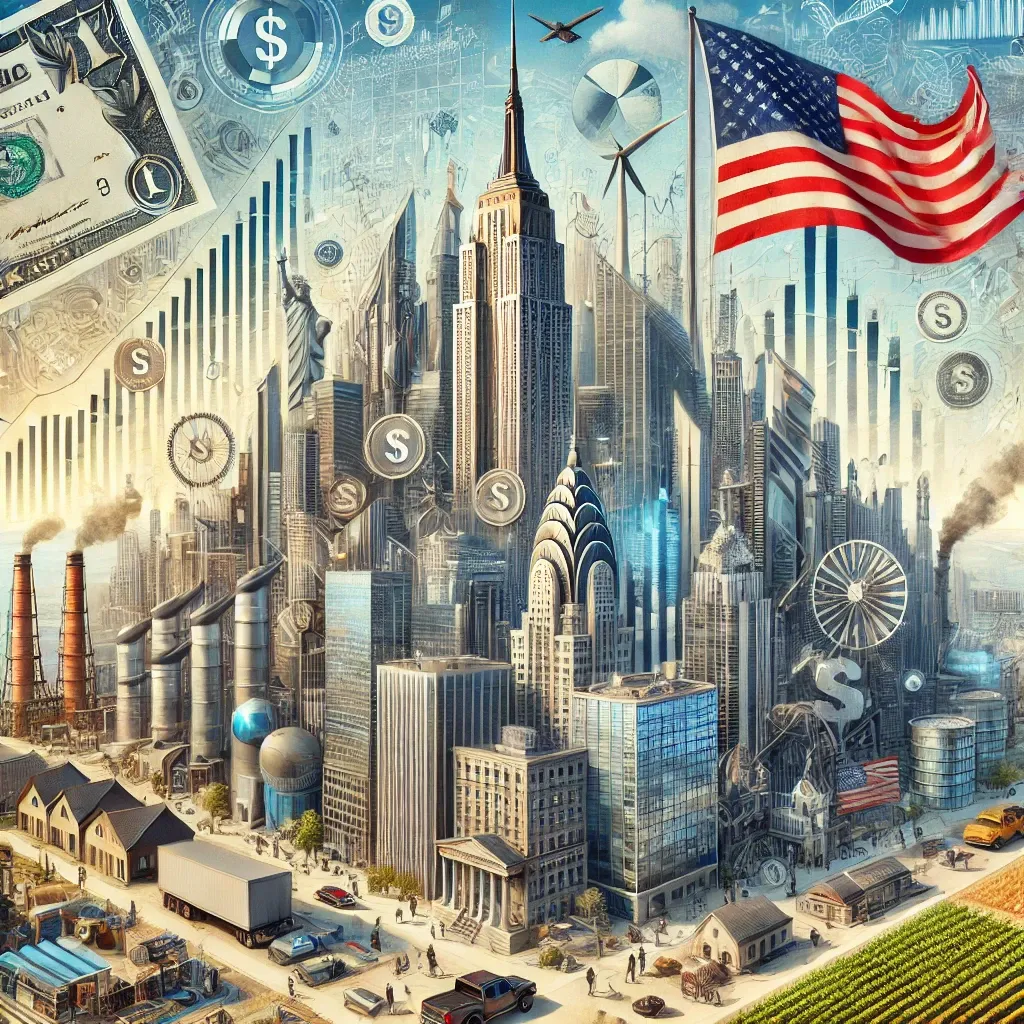Economic Report USA
The United States, the world’s largest economy, has exhibited remarkable economic growth over recent decades. However, this success masks underlying challenges in workforce participation, income inequality, innovation, and infrastructure.

Introduction
The United States, the world’s largest economy, has exhibited remarkable economic growth over recent decades. However, this success masks underlying challenges in workforce participation, income inequality, innovation, and infrastructure. By analyzing key factors like labour dynamics, migration, energy use, and innovation, we can identify strengths, weaknesses, and opportunities for sustained growth.
Key Findings
1. Economic Performance
- The USA is the largest economy globally, driven by high productivity, consumer spending, and technological innovation.
- GDP growth has consistently outpaced most developed economies, including the European Union.
- The dominance of the US dollar as a global reserve currency attracts international investment, further bolstering economic stability.
2. Labour Force and Productivity
- Labour force participation has declined over the last few decades, particularly among men aged 25–54, due to factors like skills mismatch, wage stagnation, and disillusionment with available job opportunities.
- Productivity remains high, driven by access to advanced tools, technology, and streamlined workflows.
- The rise of the gig economy provides flexibility but often lacks long-term stability and benefits for workers.
3. Migration Dynamics
- Immigration has played a pivotal role in maintaining workforce size and addressing skill shortages.
- High-skilled visas (e.g., H-1B) attract global talent, especially in technology and research sectors.
- However, the US struggles with balancing border control policies, undocumented migration, and the need for low-wage labour in agriculture and services.
4. Energy and Infrastructure
- The USA benefits from abundant natural resources, including oil, gas, and renewable energy potential, ensuring energy security.
- The country leads in energy-intensive industries, but the infrastructure to support widespread adoption of renewables lags.
- Aging infrastructure, such as bridges, railways, and water systems, hinders growth and competitiveness.
5. Innovation and Technology
- The USA is the global leader in technological innovation, driven by Silicon Valley, top-tier universities, and venture capital availability.
- Companies like Apple, Google, and Amazon contribute significantly to economic output but concentrate wealth and influence in limited sectors.
- Uneven access to technological tools and education creates disparities between urban hubs and rural areas.
6. Social and Economic Disparities
- Income inequality is among the highest in developed nations, with wealth concentrated in the top 10% of households.
- Healthcare access remains a critical issue, with millions uninsured or underinsured, despite the USA spending more on healthcare per capita than any other country.
- Disparities in education funding and outcomes perpetuate cycles of poverty and inequality.
Key Areas of Focus
1. Labour Dynamics
- The USA faces a declining birth rate, necessitating reliance on immigration to sustain workforce growth.
- Workforce automation is increasing productivity but displacing low- and mid-skill jobs, particularly in manufacturing and retail.
- Reskilling initiatives are underfunded, leaving many workers without pathways to higher-paying roles in technology-driven industries.
2. Migration Policy
- High-skilled immigrants contribute significantly to economic growth but face visa and residency bottlenecks.
- A polarized political landscape complicates reforms for undocumented workers and broader immigration policy.
- Remittances sent abroad by immigrant workers create financial outflows but foster global economic interdependence.
3. Energy and Climate Policy
- Domestic energy production, particularly through shale oil and gas, has made the USA energy-independent.
- However, the transition to renewables is inconsistent, with policy vacillating between climate commitments and fossil fuel interests.
- Infrastructure upgrades for energy efficiency, EV adoption, and grid modernization are lagging behind targets.
4. Innovation Ecosystem
- The USA leads in research and development (R&D) spending but risks complacency as other countries, especially China, catch up.
- Concentration of innovation in coastal cities exacerbates regional economic disparities.
- STEM education is underfunded relative to the growing demand for technically skilled workers.
5. Social Equity
- Rising housing costs, especially in urban areas, limit upward mobility and exacerbate homelessness.
- Healthcare costs consume a disproportionate share of household income, reducing disposable income and savings.
- The student debt crisis hinders young Americans’ ability to invest in housing, businesses, and long-term financial stability.
Opportunities for Improvement
Innovation
- Policy Action: Increase federal funding for R&D, especially in AI, renewable energy, and biotechnology.
- Private Sector Role: Incentivize technology firms to expand operations in underserved regions.
Infrastructure
- Policy Action: Launch a large-scale infrastructure modernization program focused on sustainability and resilience.
- Private Sector Role: Encourage public-private partnerships for critical projects like smart grids and high-speed rail.
Workforce Development
- Policy Action: Expand access to affordable reskilling programs in collaboration with industry leaders.
- Private Sector Role: Develop apprenticeship programs and on-the-job training initiatives for displaced workers.
Migration
- Policy Action: Reform visa systems to prioritize high-skilled workers while creating pathways for undocumented workers to participate in the formal economy.
- Private Sector Role: Advocate for immigration policies that address talent shortages.
Energy Transition
- Policy Action: Provide subsidies for renewable energy production and adoption.
- Private Sector Role: Invest in clean energy startups and domestic manufacturing of green technology.
Comparative Insights
- The USA’s reliance on innovation and its globally dominant financial system provide significant advantages but leave it vulnerable to systemic risks like wealth concentration and infrastructure decay.
- Unlike the EU, the USA benefits from energy independence and fewer regulatory barriers but faces similar challenges in sustaining a growing, skilled workforce.
- Both regions must address rising income inequality and declining labour participation to ensure long-term stability.
Conclusion
The USA remains a global leader in economic output and innovation, but unresolved challenges threaten its long-term trajectory. Focusing on infrastructure, workforce development, and social equity while maintaining its innovative edge can ensure sustainable growth. Addressing these issues requires a balanced approach, integrating federal initiatives, private sector collaboration, and international partnerships.
